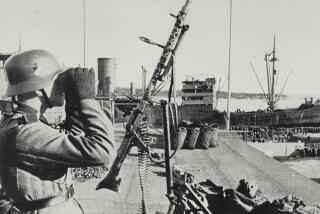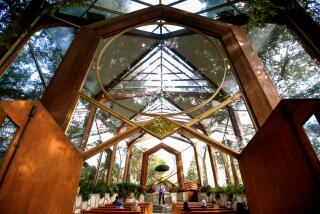A Refuge for Scandinavian Seamen : San Pedro Church Offers a Holiday Haven in L.A. Area
- Share via
The freighter Ferncroft glides into Los Angeles Harbor, its Norwegian flag snapping crisply in the December morning gust. Within its bright red hull is the cargo it has carried from Vancouver Island--giant rolls of newsprint.
Aboard the 3-year-old ship, 16 Norwegians--10 officers and six crew members--stand at attention as the strains of the Norwegian national anthem are beamed across the straits from shore: The musical welcome emanates from a rooftop loudspeaker atop the Norwegian Seamen’s Church, located on the Beacon Street bluff overlooking the San Pedro waterfront.
Sporting a tweed jacket over the bright red shirt he donned for an earlier Christmas luncheon at the church, the Rev. Arne O. Oystese, 35, strides toward the ship, carrying not a Bible, but the latest batch of Norwegian newspapers.
As soon as the battalion of skip loaders scoop the final bale of paper from the hold, the ship will set sail again. With technological advances and stiff competition, harbor layover time is drastically curtailed. Gone are the days when crew members had a week of shore leave for legendary visits to the waterfront bars and brothels of old San Pedro.
A Drastic Change
“Those days are history now,” Oystese said. “San Pedro has changed. The waterfront has been cleaned up. And the shipping industry has changed drastically in the last few years. Ten years ago, we saw 400 Norwegian ships a year come through here. Now it’s only half that.”
Whereas Norway has the fourth largest shipping fleet in the world, “more and more Norwegian ship-owners are being forced to flag-out to other countries with more competitive wage scales. So we have less Norwegian seamen to deal with,” Oystese said. In 1984, of the 630 ships the church pastors visited, 200 were Norwegian, 200 Danish, 100 Swedish, and 130 from other countries such as Panama, the Philippines or Liberia, but carrying some Scandinavian seamen.
“Of the 100 people a day who visit the mission, only 15 to 20% are seamen these days. The others will be the members of the local Norwegian colony, whom we are also here to serve. In fact, they are now our major emphasis.”
That’s why Oystese and his assistant, Dagfinn Misje, go down to the ships to “visit our congregation on their turf,” as Misje explained. The two Norwegians, a well as the Swedish pastor attached to the church, visit an average of 55 ships each month.
The Ferncroft will be in port for one day, long enough for its mechanic, Erik Tapio, 37, to drop in at the Seamen’s Church, a two-story white stucco building marked by the colorful flags of the Scandinavian countries.
First established in San Pedro in 1941, the existing building with its sanctuary, social hall, reading room, gift shop (where Norwegian chocolates and the latest hit cassettes are sold) and offices was built in 1951. It also includes tennis courts, a pool hall, swimming pool and patio area.
“The first thing I want to do is call home,” said Tapio, who looks every bit like an able-bodied Viking seaman. He will be at sea for four months before returning to Norway, and homesick sailors like Tapio chalk up more than 2,000 long-distance calls a year from the Seaman’s Church pay phone.
Tours of duty vary from three months to six. “It used to be worse,” said Magnar Gjerde, radio officer aboard the Ferncroft, which recently celebrated its 100th Vancouver to Southern California voyage. “When I started in this work 30 years ago, we had to sign up for two years at a time.”
Tour-Guide Services
Still, time in port can be lonely and boring without the hospitality--and “tour-guide” type services--that the Seamen’s Church offers. On one typical day, a group of 25 Finnish seamen were being taken to Disneyland, and another group of Norwegians were on their way to Magic Mountain in the mission’s van.
“Sometimes they want to go to the shopping centers to buy gifts for their families,” Oystese said. With the closing in 1983 of the Norwegian State Welfare Agency for Seamen, the Seamen’s Church also took over the handling of emergencies and family matters that might arise.
Most of the time, all a seamen needs is a little Norsk hospitality. “I come here to read the Norwegian newspapers, talk a bit with the people here, have some coffee and of course, some vafler ,” Tapio said.
The fragrant Norwegian vafler are a tradition at the 25 Norwegian Seamen’s Mission churches throughout the world, located in ports frequented by Norwegian ships in Europe, and as far away as Singapore and Dubai. San Pedro is one of seven sites in the United States, with others in New Orleans, New York, Baltimore, Houston, Miami and San Francisco.
In the spacious kitchen at the San Pedro center, more than 500 of the heart-shaped waffles are prepared daily under the supervision of Anny Urtegard, a Norwegian home-economics teacher who is the Seamen’s Church official housekeeper and hostess.
“The seamen would be very disappointed if they came here and there were no waffles,” she said. “They have come to expect them at all the Norwegian Seamen’s churches.”
Laced with cardamom seed, an exotic spice first introduced to Norway more than 1,000 years ago by seamen returing from trading voyages in the Middle East, the waffles are traditionally served at room temperature, sweetened by strawberry or raspberry preserves.
At no time of year are the waffles more welcome--or the seas more cold and lonely--than in the days and nights before Christmas. In one corner of the church stood a rotund Christmas tree from Canada, recently unloaded from the Ferncroft, and decorated--Norwegian style--with streamers of miniature Scandinavian flags.
On the walls in the social hall and reading room are hand-woven Norwegian tapestries, a shelf of gleaming copper kettles over a friendly brick fireplace, and clean-lined Scandinavian modern furniture in conversation groupings. It is as meticulous as the Norwegian ships, which set world standards for shipshape tidiness.
The tradition of looking after its seamen is an ancient one in Norway, a land with 15,000 miles of fjord-laced coastline and a sea-based economy, said Norwegian vice consul Knut Ivar Halvorsen, who, along with Consul General Per Tollefsen, takes an active interest in the Seamen’s Church activities.
“With so many of Norway’s people living near the sea, nearly every family has a son or husband out on a ship somewhere in the world,” Halvorsen said.
Established in 1864
The Norwegian Seamen’s Mission was established in 1864, with headquarters in Bergen. “There are thousands of people in Norway who raise money for it,” Halvorsen said, adding that the mission is separate from the state church, although it is the same Lutheran body and has the same ministers.
Salaries of the pastor and his staff are paid by the Bergen office, but the money maintaining the church must be raised by the local community, which uses the mission as a cultural center and meeting place. Receptions are often held at the church for visiting members of the Norwegian royal family or other dignitaries and artists.
At many of these occasions, Pastor Oystese often shows up with his wife, Wenche, and their two sons, Olav, 8, and Asbjorn, 6, all clad in the colorful Norwegian festival garments called bunad . Oystese and his family have been in San Pedro for 2 1/2 years now, and will return in another three years to their home in a small village in the Hardanger Fjord area of Norway where Oystese will become a regular parish minister again.
Oystese never forgets, he said, that the real purpose behind the Seamen’s Mission is to function as a church. Regular Lutheran worship services are held in Norwegian at 11 a.m. every Sunday, with a Swedish language service conducted one Sunday of the month by the Rev. Johan Wierup, the mission’s Swedish pastor, and there is an active Sunday School program.
A short devotion service and Bible-reading session take place every evening, and the pastor and his staff are always available for counseling or spiritual guidance.
“We offer a Christian home away from home,” said assistant pastor Misje, a fisherman in Norway before taking up with the Seamen’s Church. “This is something we like to emphasize because it is the reason we are here in the first place.
“When they first went out to build the seamen’s churches, it wasn’t just the Norwegian ships that went into a harbor. There would also be the merchants and traders that went along with it, and before you’d know it, a Norwegian community would spring up,” said another transplanted Norwegian, Trond Woxen, who grew up as the son of a minister serving at the now-defunct Philadelphia Norwegian Seamen’s Church, and now is artistic director of the Los Angeles-based Scandinavian Theatre Company.
The community also includes one-time seamen such as Birger Hanen of San Pedro, a 74-year-old retired mechanic and former seaman who emigrated from Norway after World War II. Twice a week, he picks up nearly 400 copies of the latest Norwegian newspapers and periodicals at Los Angeles International Airport, fresh off a plane from Oslo.
Like many Norwegian-Americans who congregate at the church, Hansen is an active member of the Sons of Norway, a nationwide fraternal organization with several lodges in Southern California, where there are at least 2,000 Norwegian citizens and anywhere from 20,000 to 50,000 Norwegian-Americans.
Visiting ‘Family’
But it is not only Norskies who frequent the church. Veteran Danish officer Torben Richardt, 50, is a regular visitor at the Seamen’s Church. “It’s like coming to visit family,” he said. Smoking a pipe, the bearded captain helped himself to a Norwegian delicacy, taking a pre-Yule respite from his Korean ship’s regular banana run from Panama to Los Angeles. When Christmas Day arrives, he’ll be “somewhere off the coast of Acapulco,” he said. He was used to it.
Surprisingly, the Seamen’s Church in San Pedro will not see a large gathering of seamen on Christmas. “There will be celebrations on all the ships at sea that day,” said church caretaker John Ivar Kopperud, who rings the church’s brass bell every Sunday, following the old Norwegian tradition.
Kopperud is one of three staff members who actually live in apartments on the premises. There is no provision for seamen to spend the night or to eat regular meals there. Instead, they stay aboard ship, taking shore-leave meals in restaurants. But coffee and waffles--that’s another matter.
In the last few years, several of the original 35 Norwegian Seamen’s churches have been closed due to lack of a seafaring Norwegian population to serve. But the future still looks bright for the Beacon Street church. “With such an active Norwegian-American community, even with half the seamen coming into port, we’ll be kept busy,” Oystese said.
And he promises the waffles will be around long after the last seaman takes his last ocean voyage.
More to Read
Sign up for The Wild
We’ll help you find the best places to hike, bike and run, as well as the perfect silent spots for meditation and yoga.
You may occasionally receive promotional content from the Los Angeles Times.






